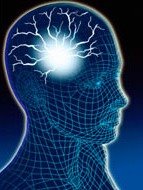The Difference Between Knowing and Remembering: Consciousness and Theta Synchronization?
 In the remember/know procedure, subjects first study a list of words and some time later are presented with a series of probe words. Subjects must indicate whether they have a specific conscious recollection of studying that word ("remember"), whether they know they studied the word but cannot specifically remember the study episode ("know"), or whether they did not encounter the word previously.
In the remember/know procedure, subjects first study a list of words and some time later are presented with a series of probe words. Subjects must indicate whether they have a specific conscious recollection of studying that word ("remember"), whether they know they studied the word but cannot specifically remember the study episode ("know"), or whether they did not encounter the word previously.This test is standardly used to assess damage in amnesics, where medial temporal lobe damage impairs "remember" judgments more than "know" judgments. These terms can be seen as isomorphic with "recollection" and "familiarity." In single process models of long-term memory, familiarity involves resonance among non-hippocampal medial temporal lobe structures, whereas recollection involves that resonance in addition to resonance within the hippocampus itself.
However, another way of looking at remember/know judgments is that correct remember judgments involve some aspect of consciousness, while correct know judgments do not. This led Klimesch et al to investigate the differences between "remember" and "know" judgments with ERP and an eye to previous findings about the neural correlates of consciousness.
The authors found a maximal peak in scalp voltage at 356.6 ms for items which subjects "knew" but could not specifically "remember." This component of the signal was maximal for known items, minimal for new items, and in-between for remembered items. In contrast, a different peak at 591 ms was maximal for items which subjects "remembered" being presented, minimal for new items, and in-between for "know" items.
When the authors viewed the dominant frequencies over time, rather than dominant amplitudes over time, they discovered a very different pattern. In this case, there was an increase in theta-band power for correct over incorrect judgments of all three types - new, remembered, and known. However, these three judgment types differed both in terms of the time course and the duration of the theta-band power increase: the duration of power increase was longest for remember items, and this came later than power increase resulting from the other judgment types. The duration of theta-band power increase was shortest for new items, and in-between for known items, this increase in power for known items occurred before the power increases for remember and new judgments.
The authors interpret the late but lengthy increase in theta-band power for "remember" judgments as resulting from reentrant hippocampo-cortical loops. In contrast, the early and relatively short increase in theta-band power for "know" judgments is interpreted to result from resonance within perirhinal and other medial temporal lobe structures.
Broadly speaking, these results are consistent with a single-process model, in which resonance within perirhinal cortex contributes to the theta-band power increases in remember judgments. This power increase is lengthened by an additional process in remember judgments, specifically resonance throughout hippocampo-cortical loops.
What are the implications of this research with regard to consciousness? The authors note there seems to be no simple one-to-one mapping of power increase (which they presume reflects "synchronization," though others have shown this is not necessarily so) to consciousness. However, one somewhat hasty conclusion would be that duration of power increases, but not necessarily the magnitude of power increases, correlates with consciousness.
The authors note previous work that has shown theta-band power increases during REM relative to "non-conscious" sleep, as well as increased power during animal exploratory behavior and orienting relative to "automatic" processes such as eating or drinking. Other research that I have reviewed previously implicates the theta-band in the maintenance of information, the modulation of gamma-band power (which has also been widely implicated in consciousness), as a 'neural pacemaker' for alternating retrieval and encoding processes, and as phase-sensitive both to spatial encoding and to the onset of events in the environment.
Related Posts:
The Argument for Multiplexed Synchrony
Theta Frequency Reset in Memory Scanning
Separate Phases for Encoding and Retrieval in Theta Rhythms
Strength Through Synchrony
Binding Through Synchrony: Proof from Developmental Robotics


0 Comments:
Post a Comment
<< Home